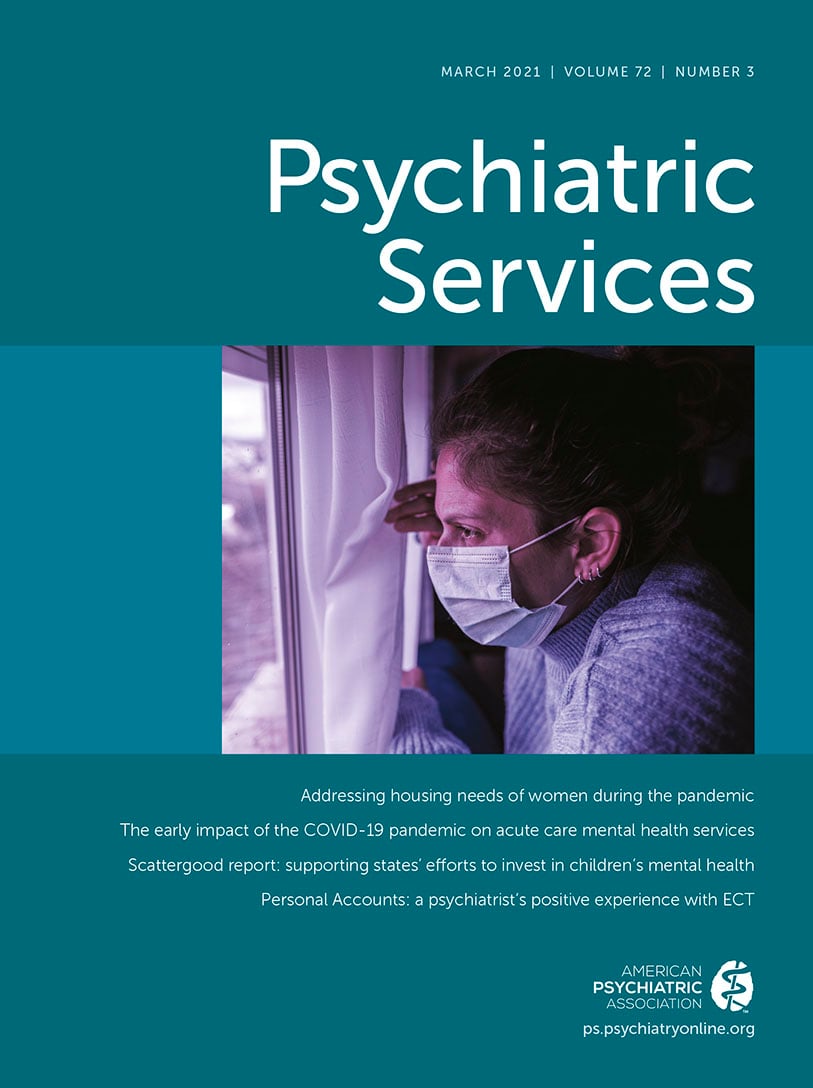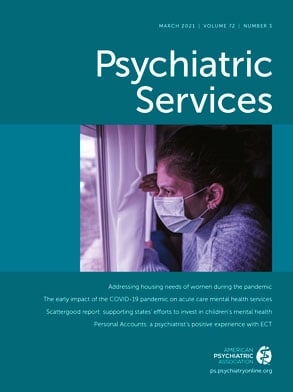Growing literature supports that intervening at the moment of a first episode of psychosis is critical for maximizing recovery, resulting in fewer future hospital admissions and better overall functioning (
1–
4). Coordinated specialty care (CSC), a team-based approach that provides evidence-based pharmacological treatment, individual support, family education, and appropriate care coordination, has demonstrated greater effectiveness than usual care for first-episode psychosis (FEP) (
3,
5). Most recently, a landmark study of the Recovery After an Initial Schizophrenia Episode–Early Treatment Program (RAISE-ETP) refined and validated this treatment approach (
6).
The goal of RAISE-ETP was to test the effectiveness of CSC versus usual community treatment among individuals experiencing FEP. NAVIGATE, the CSC intervention in RAISE-ETP, used a team-based approach that included shared decision making, a focus on patient strengths and resiliency (using cognitive-behavioral therapy methods), motivational enhancement, and psychoeducation. Core interventions included individual resiliency therapy, supported education and employment, and individual algorithm-based medication management tools to guide medication prescribing. Family education and care coordination were included to ensure appropriate treatment. NAVIGATE participants experienced significantly greater improvements in self-rated quality of life, depression, and symptom severity over a 2-year period compared with the community care group (
3). These effects were largely mediated by duration of untreated psychosis.
Despite guidelines supporting best practices, gaps exist between recommended and actual treatment of schizophrenia, which lead to poorer outcomes, increased hospitalizations, and decreased quality of life (
5,
7,
8). Clinician factors, such as lack of awareness or familiarity with guidelines, disagreement with guidelines, and inertia of previous practice, may influence prescribing practices (
9). Patient factors, including gender, race-ethnicity, age, insurance status, and patient preference, may also influence prescribing practices (
10).
As our understanding of how to best treat FEP evolves, support is needed for efforts to facilitate consistent implementation of evidence-based practices across populations. A first step is to develop methods to assess quality of care in a manner that is cost effective and that generates actionable information. For this study, we developed quality measures on the basis of the principles included in the RAISE-ETP, in the Schizophrenia Patient Outcomes Research Team (PORT), and in other sources that characterize best practices in terms of psychopharmacological treatment, provision of psychosocial interventions, coordination of care, and appropriate health monitoring. The primary aim of this exploratory work was to apply these measures to a Medicaid database to characterize the state of treatment for individuals with FEP on the basis of these actionable quality indicators (QIs). The secondary aim was to investigate the relationship between quality of care and patients’ future health care utilization. Our hypothesis was that deviation from best practices would be associated with increased utilization of emergency and hospital services due to suboptimal quality of care.
Discussion
This study evaluated the utility of 10 QIs to assess the quality of care among patients in a Medicaid claims database. Our results highlight the areas of treatment of FEP that most likely diverge from recently updated treatment recommendations. With a few exceptions, our results for the metrics related to medication prescribing were qualitatively similar to those identified by Robinson and colleagues in the RAISE-ETP data set. For example, 5% of patients prescribed antipsychotic medication received it at a higher than recommended dose, which is similar to the 8.8% reported in the RAISE-ETP study (
10). Almost 20% of patients were prescribed olanzapine, which is slightly higher than the 16% reported in the RAISE-ETP study (
10). Finally, 16% of our cohort was prescribed two or more antipsychotics, whereas the RAISE-ETP study reported 9%. These data suggest that gaps between evidence-based recommendations and usual care are still large and deserve attention from policy makers and administrators. An important qualification is that we did not adjust for concurrent therapeutic interventions nor for the order of treatments. It is possible that use of high-dose antipsychotics, polypharmacy, and olanzapine or clozapine was preceded by more appropriate but less effective treatment.
Psychopharmacology practices that are not recommended for the treatment of FEP (olanzapine as first-line treatment, antipsychotic polypharmacy, and doses higher than recommended) were associated with lower treatment utilization in within-patient analyses. Because the follow-up period for examining utilization began when criteria of a QI were met, this association could reflect a “step up” in treatment strategy after initial approaches using antipsychotic medications failed. Although these practices (except for use of clozapine) have not shown superior treatment efficacy compared with treatment as usual, they could have resulted in decreased need for emergency and inpatient services. It is also possible that a step up in treatment strategy included additional psychosocial interventions that were not captured by our analysis. Further study will be required to better understand these observations.
Our results showed that 44% of patients had at least one episode during the measurement period where they failed to refill antipsychotic medication. These results are comparable with other real-world cohorts. For example, using the Finnish national registry, Tiihonen et al. (
16) found that 41.8% of individuals with FEP failed to fill a prescription for antipsychotic medication after hospital discharge, and 54.3% did not do so within 3 months of discharge; other studies have found similar results (
17–
19). We found, to our surprise, that this QI was associated with reduced ED and inpatient utilization. Individuals with FEP who feel better may feel more comfortable discontinuing treatment because they may feel that they do not need it (
20,
21). Data from similar studies suggest that median time to relapse after treatment interruption in this population is longer than a year (
22). Therefore, it is possible that individuals who discontinued were less symptomatic initially, with an apparent lower risk of relapse in the short term but greater risk of relapse in the mid- to long term, which was not captured within our observation window. In our sample, 13.1% of participants were treated during the observation period with at least one dose of LAI antipsychotics. Although the patterns of LAI use were not studied, we observed that approximately 12% of participants who did not refill an antipsychotic medication (QI 5) received an LAI in the subsequent 2 months. The low utilization rate of LAIs in this population, well below the average for patients with schizophrenia in general (
20), is alarming given that a majority of individuals with FEP relapse, especially when they do not adhere to treatment (
21,
22), and that psychosis relapse is associated with detrimental effects on recovery and potentially danger to self or others. LAIs have proven to be effective and well tolerated to treat FEP (
23), yet our data illustrate how underutilized they are in this population.
An important aspect of prescribing antipsychotics is the consistent monitoring of weight and metabolic parameters (
24). Even though this recommendation has been widely publicized since 2004 (
25), 34% of patients receiving second-generation antipsychotics had no evidence of receiving metabolic screening in the 12-month evaluation period. This finding is of concern given the relatively high use of olanzapine. We are not aware of studies reporting metabolic monitoring rates in a population of individuals with FEP. However, in a large general Medicaid population receiving antipsychotics, 20.4% lacked evidence of annual glucose testing, and 58.8% lacked evidence of annual lipid screening (
26). Our findings appear to be generally consistent with this report, although we credited a case as having monitoring if any of the individual tests were observed in the follow-up period. This method would be more likely to overestimate the level of monitoring. Lack of monitoring was associated with a lower likelihood of near-term service utilization, which may reflect less concern by providers with “less sick” patients, whereas providers would be more likely to conduct a more thorough assessment of patients at greater risk.
One of the RAISE-ETP treatment benchmarks states that antidepressants should not be prescribed in the absence of a diagnosis of depression or anxiety disorder. We found high rates of depression or anxiety disorder diagnosis (73.1%) and antidepressant use (71.1%), suggesting high rates of comorbid conditions with FEP. Approximately 20% of patients receiving antidepressants had no justifying diagnosis. Although this figure is substantially lower than the 50.4% of patients in the RAISE-ETP study (
10), this finding still requires attention by policy makers.
We examined several QIs that were not related to medication. There was no evidence of psychotherapy (QI 1) or integrated care (QI 8) in 71% and 22% of the cohort, respectively. These indicators may be underreported in our data set because psychotherapy or activities related to care coordination could be bundled with other procedure codes. Efforts should be made to increase the use of psychotherapy in treatment of FEP because it has been shown to be effective (
27). Although a CSC approach is slightly more costly than usual care, it results in significantly higher quality of life, which offsets the costs (
28). Lack of claims evidence for psychotherapy and integrated care delivery were both associated with across-the-board increases in future health care utilization. These data highlight the gap between evidence-based recommendations and real-world utilization of nonpharmacological treatment elements, given the positive impact they may have on outcomes such as treatment utilization.
Comorbid substance abuse in this study was greater than what was reported in RAISE-ETP, with over two-thirds (70.3%) of participants meeting criteria for comorbid substance use. This finding highlights the need to make addiction interventions central to treatment of early psychosis. A finding of great concern is that despite such high incidence of comorbid substance use disorders, monitoring for substance abuse was reported for less than one-fifth of the patients. It is possible that monitoring was being addressed in ways that are not captured by claims data. In our sample, lack of monitoring was associated with greater treatment utilization, which attests to the large need for the treatment of comorbid substance use disorders in the population with FEP.
These results should be interpreted in the context of several methodological limitations. For instance, our sample was derived from Medicaid claims data, which may not be representative for individuals with FEP whose treatment is reimbursed by private insurance. Also, the stratified Cox regression minimizes confounding by indication; however, the prognosis of a single patient may change over the course of follow-up. This change may result in noncomparable risk between the period before and after the criteria of a QI were met. We mitigated this limitation by conducting adjusted analyses for co-occurring treatments when a QI was met and for order of QIs. Therefore, associations may not be explained only by causality. Unmeasured, confounding differences in treatment severity, inaccurate billing of QI-related interventions, or regression to the mean (where patients whose illness was more acute and who had previously received interventions such as antidepressants, olanzapine, or clozapine regressed to the mean over follow-up) could explain these findings as well. These limitations of using claims data are in tension with the advantages of obtaining information for large populations and of limiting selection bias. Therefore, our results should be interpreted in the context of other literature, such as randomized controlled trials. A final limitation was that claims diagnoses may not be as reliable as research diagnoses.

